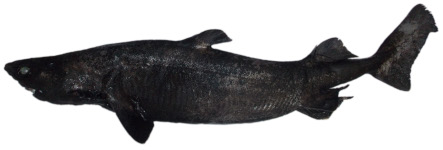Scymnodon ichiharai
Yano & Tanaka, 1984
Japanese velvet dogfish
Classification: Elasmobranchii Squaliformes Somniosidae
Reference of the original description
Review of the deep sea squaloid shark genus Scymnodon of Japan, with a description of a new species. Japanese Journal of Ichthyology, 30(4), 341–369
Review of the deep sea squaloid shark genus Scymnodon of Japan, with a description of a new species. Japanese Journal of Ichthyology, 30(4), 341–369
Image of the original description
Image in copyright.
Image in copyright.
Synonyms / new combinations and misspellings
Scymnodon ishiharai, Zameus ichiharai
Scymnodon ishiharai, Zameus ichiharai
Types
Scymnodon ichiharai
Holotype: NSMT: P 21723; Paratype: BMNH: 1983.11.8.1; FUMT: P 3850; FUMT: P 3849; MSM: 80-273; MSM: 80-274; NSMT: P 21724; TMFE: 76; TMFE: 78; TMFE: 169; TMFE: 288; TMFE: 1138; TMFE: 1275; TMFE: 1875;
Scymnodon ichiharai
Holotype: NSMT: P 21723; Paratype: BMNH: 1983.11.8.1; FUMT: P 3850; FUMT: P 3849; MSM: 80-273; MSM: 80-274; NSMT: P 21724; TMFE: 76; TMFE: 78; TMFE: 169; TMFE: 288; TMFE: 1138; TMFE: 1275; TMFE: 1875;
Description :
Citation: Scymnodon ichiharai Yano & Tanaka, 1984: In: Database of modern sharks, rays and chimaeras, www.shark-references.com, World Wide Web electronic publication, Version 12/2025
Please send your images of "Scymnodon ichiharai" to info@shark-references.com

Scymnodon ichiharai Yano & Tanaka, 1984; Will White, CSIRO, Australia

Scymnodon ichiharai Yano & Tanaka, 1984; Will White, CSIRO, Australia
Common names
 Japanese velvet dogfish
Japanese velvet dogfish
 Japanese velvet dogfish
Japanese velvet dogfish
Short Description
Original diagnosis of White et al. (2014) [21593]: A large species of Scymnodon with dermal denticles along the trunk with pedicelated crowns, supporting dorsal leaf-like blades, with posterior margin of blade straight, slightly undulated, or serrated [vs. posterior margin of dorsal blade strongly tridentate in S. ringens, S. plunketi (Fig. 7b), and S. macracanthus]. Scymnodon ichiharai is further distinguished from S. ringens by possessing only oblique cusps on the lower jaw teeth, without any symmetrical symphysial tooth (vs. lower jaw with a symphysial tooth with an erect main cusp in S. ringens), dermal denticles with three to five longitudinal ridges extending throughout the extension of the blade (vs. dermal denticles with anterior concavity in S. ringens). Scymnodon ichiharai is further distinguished from S. plunketi (Fig. 8) and S. macracanthus by having main cusps of lower teeth less oblique, and outer margin of main cusp almost erect (vs. strongly oblique main cusps on lower teeth, with both inner and outer margins of cusps obliquely positioned in S. plunketi and S. macracanthus). Additionally, S. ichiharai is distinguished from S. plunketi by a slightly more slender pectoral fin (S. ichiharai with pectoral fin posterior margin from 4.6–6.9 % TL vs. 7.6–8.8 % TL in S. plunketi).
Original diagnosis of White et al. (2014) [21593]: A large species of Scymnodon with dermal denticles along the trunk with pedicelated crowns, supporting dorsal leaf-like blades, with posterior margin of blade straight, slightly undulated, or serrated [vs. posterior margin of dorsal blade strongly tridentate in S. ringens, S. plunketi (Fig. 7b), and S. macracanthus]. Scymnodon ichiharai is further distinguished from S. ringens by possessing only oblique cusps on the lower jaw teeth, without any symmetrical symphysial tooth (vs. lower jaw with a symphysial tooth with an erect main cusp in S. ringens), dermal denticles with three to five longitudinal ridges extending throughout the extension of the blade (vs. dermal denticles with anterior concavity in S. ringens). Scymnodon ichiharai is further distinguished from S. plunketi (Fig. 8) and S. macracanthus by having main cusps of lower teeth less oblique, and outer margin of main cusp almost erect (vs. strongly oblique main cusps on lower teeth, with both inner and outer margins of cusps obliquely positioned in S. plunketi and S. macracanthus). Additionally, S. ichiharai is distinguished from S. plunketi by a slightly more slender pectoral fin (S. ichiharai with pectoral fin posterior margin from 4.6–6.9 % TL vs. 7.6–8.8 % TL in S. plunketi).
Distribution
Northwest Pacific: Suruga Bay and adjacent waters of Japan, off Cheng-gong, Taitung, in southeastern Taiwan [21593]
First record: Andaman Waters, India (Kumar et al. 2024, [33047])
Northwest Pacific: Suruga Bay and adjacent waters of Japan, off Cheng-gong, Taitung, in southeastern Taiwan [21593]
First record: Andaman Waters, India (Kumar et al. 2024, [33047])
Dentition
23 (17–30) ? 0 (0–1) ? 22 (20–28)/14 (13–16) ? 0 (0–1) ? 15 (13–15); total 45 (38–58)/29 (27–31) [21593]
23 (17–30) ? 0 (0–1) ? 22 (20–28)/14 (13–16) ? 0 (0–1) ? 15 (13–15); total 45 (38–58)/29 (27–31) [21593]
Remarks
shark-references Species-ID=6437;
shark-references Species-ID=6437;

















